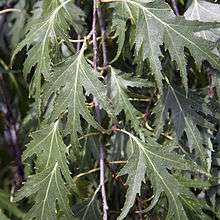Ornäs birch


The Ornäs birch, (Swedish Ornäsbjörk, Latin Betula pendula 'Dalecarlica') is a variety of silver birch with deeply indented leaves. It is the national tree of Sweden.
History
The original Ornäs birch was discovered in 1767 by Hans Gustaf Hiordt in the municipality of Ornäs, in the central Swedish province of Dalarna. Hiordt sent a description of the tree to the renowned botanist Carl Linnaeus in the Swedish university city of Uppsala. Cuttings were taken from the original tree, from which all Ornäs birch trees have been propagated. In 1985 the Ornäs birch was named as the national tree of Sweden, and examples have been planted in central locations in many Swedish towns.
Description
Ornäs birch trees grow to a height of 20–25 metres, and have a rounded, somewhat uneven crown. The main branches have an acute angle to the trunk, and only the outermost branches are hanging. The Ornäs birch is often confused with the similar birches Betula pendula 'Crispa' and Betula pendula 'Laciniata', and all three varieties are sometimes sold commercially as "Swedish birch". The genuine Ornäs birch can be distinguished by its growth-form, and in that its leaves are more deeply indented than the other varieties. Male flowers are absent, so the Ornäs birch can only be propagated from cuttings. Female flowers are present however, so hybrids can be produced by cross-pollination.
